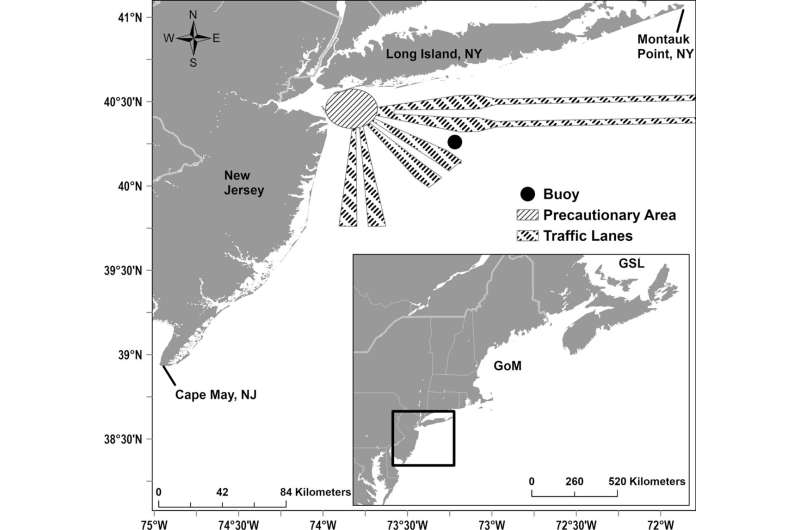This article has been reviewed according to Science X's editorial process and policies. Editors have highlighted the following attributes while ensuring the content's credibility:
fact-checked
trusted source
proofread
New research reveals New York Bight is an important year-round habitat for endangered fin whales

The New York Bight is an important year-round habitat for endangered fin whales, according to new research examining fin whale song patterns.
This new paper, published by Wildlife Conservation Society (WCS) and Woods Hole Oceanographic Institution (WHOI) scientists in the journal Scientific Reports, reveals new insights about the presence and potential subpopulation distribution of fin whales (Balaenoptera physalus) in waters off New York and New Jersey ranging from Montauk, NY to Cape May, NJ.
This new research provides valuable information that can be used to inform best practices and develop effective management strategies needed to protect endangered fin whales better. For example, management strategies, like vessel speed restrictions, can be implemented seasonally if a species is only present at certain times of the year. However, when endangered animals are present year-round, seasonal strategies can leave these animals susceptible to various threats at certain times of the year.
To help better protect fin whales in the New York Bight, WCS and its partners are also promoting the development of a region-specific strategy for US management authorities that addresses the specific threats to fin whales in this region.
A study co-author and Associate Marine Conservation Scientist with the Ocean Giants Program at WCS, Dr. Mindi Rekdahl, said, "More information is needed about the distribution and behavior of fin whales within the New York Bight to help inform how this endangered species can be protected from the range of potential stressors and threats encountered year-round in these waters."
Carissa King-Nolan, a WCS Assistant Marine Conservation Scientist and lead author, added, "In order to fill this knowledge gap, we used passive acoustic monitoring to examine monthly and yearly patterns in fin whale song from 2017 to 2020. These song patterns gave us valuable insight into the year-round presence and behavior of fin whales."
The researchers analyzed archived recordings from a total of 653 days for the presence of fin whale songs. Fin whale song was detected in every month of the year, with the song most prevalent in the fall to winter (September–December), followed by spring (March–April), and was typically sporadic from late spring to summer (May–July). Differences in the pattern, or the interval between successive song notes, were also found.
Songs during the fall to winter had short intervals between notes, and this likely represented breeding behavior wh, and this likely represented breeding behavior, while songs with longer note intervals during the spring likely represented foraging behavior. The results of this study, combined with other recent research, indicate that the New York Bight is an important year-round habitat for both foraging and breeding fin whales.

WHOI built, deployed, operated, and recovered the acoustic buoys that collected the data used in the study.
"The New York Bight buoys play a critical role in the protection of wildlife, like the fin whale, in one of the busiest waterways in the world. The data collected lets industry, government, and the public know when whales are nearby," said Mark Baumgartner, co-author and WHOI marine ecologist.
Dr. Howard Rosenbaum, Director of WCS's Ocean Giants Program and study co-author, said, "Perhaps it is time to give some further consideration to fin whales as NY/NJ's whale. While they may not be seen as close to shore as other whales and dolphins, it is truly remarkable that the second largest animal to have ever lived on this earth is here in the New York Bight year-round off our coasts."
"Hopefully, our efforts will lead to more efforts and best practices to better protect these amazing, endangered animals in the NY Bight."
More information: Carissa D. King-Nolan et al, Fin whale song characteristics and potential subpopulation identity in the New York Bight, Scientific Reports (2024). DOI: 10.1038/s41598-024-52228-8
Provided by Wildlife Conservation Society



















